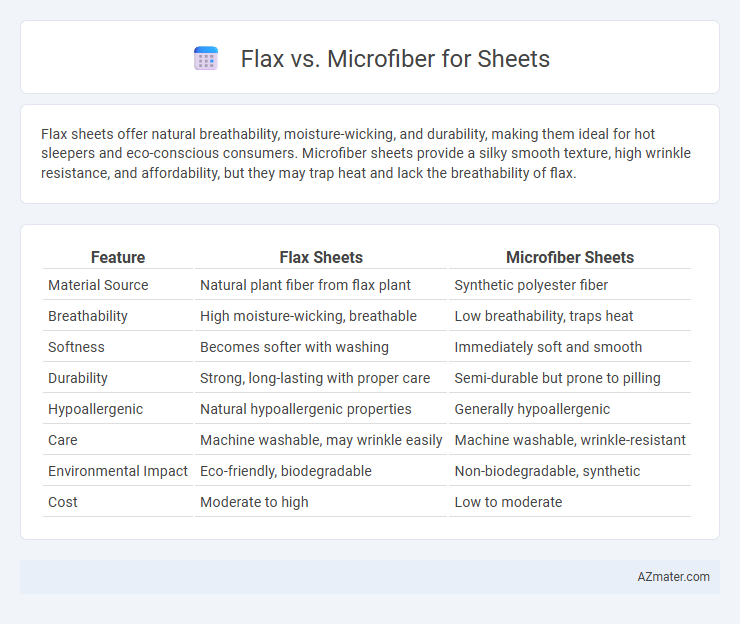Flax sheets offer natural breathability, moisture-wicking, and durability, making them ideal for hot sleepers and eco-conscious consumers. Microfiber sheets provide a silky smooth texture, high wrinkle resistance, and affordability, but they may trap heat and lack the breathability of flax.
Table of Comparison
| Feature | Flax Sheets | Microfiber Sheets |
|---|---|---|
| Material Source | Natural plant fiber from flax plant | Synthetic polyester fiber |
| Breathability | High moisture-wicking, breathable | Low breathability, traps heat |
| Softness | Becomes softer with washing | Immediately soft and smooth |
| Durability | Strong, long-lasting with proper care | Semi-durable but prone to pilling |
| Hypoallergenic | Natural hypoallergenic properties | Generally hypoallergenic |
| Care | Machine washable, may wrinkle easily | Machine washable, wrinkle-resistant |
| Environmental Impact | Eco-friendly, biodegradable | Non-biodegradable, synthetic |
| Cost | Moderate to high | Low to moderate |
Overview of Flax and Microfiber Sheets
Flax sheets, crafted from natural flax fibers, offer exceptional breathability, durability, and a soft, linen texture that improves with each wash. Microfiber sheets, made from finely woven synthetic polyester fibers, provide a smooth, wrinkle-resistant surface and are known for their affordability and moisture-wicking properties. Both options cater to different preferences in comfort and maintenance, with flax excelling in natural feel and longevity, while microfiber stands out for easy care and affordability.
Material Composition and Source
Flax sheets are made from natural fibers derived from the flax plant, specifically from linen, which offers breathability and durability due to its long, strong fibers. Microfiber sheets consist of finely woven synthetic fibers, typically polyester or nylon, engineered for a smooth texture and moisture-wicking properties. The key difference lies in flax's organic plant-based origin versus microfiber's man-made polymer composition, impacting sustainability and fabric performance.
Texture and Feel Comparison
Flax sheets offer a naturally textured, slightly coarse feel that softens with each wash, providing a breathable and moisture-wicking experience ideal for warm climates. Microfiber sheets deliver a smooth, silky surface that feels soft and lightweight against the skin, offering excellent wrinkle resistance and durability. The tactile contrast between flax's organic roughness and microfiber's synthetic sleekness influences personal comfort preferences and the sleeping environment.
Durability and Longevity
Flax sheets, made from natural fibers, are renowned for exceptional durability that improves with each wash, often lasting over a decade with proper care. Microfiber sheets, crafted from synthetic polyester, offer resistance to wrinkles and stains but tend to wear out faster, typically lasting 3 to 5 years before pilling and thinning occur. The long-lasting strength of flax combined with its breathable qualities makes it a superior choice for longevity compared to the more affordable yet less durable microfiber options.
Breathability and Temperature Regulation
Flax sheets, made from natural linen fibers, offer superior breathability and moisture-wicking properties that help regulate temperature by allowing air to circulate freely and keeping sleepers cool in warm weather. Microfiber sheets, composed of finely woven synthetic fibers, tend to trap heat and moisture, making them less effective at temperature regulation and sometimes causing overheating during sleep. For optimal breathability and temperature control, flax sheets are favored in comparison to microfiber options.
Moisture-Wicking and Absorption
Flax sheets, made from natural fibers in linen, offer superior moisture-wicking and breathability compared to microfiber, efficiently drawing sweat away from the skin and allowing faster evaporation. Microfiber sheets, composed of finely woven synthetic fibers like polyester, absorb less moisture and tend to trap heat, making them less effective for moisture management. For sleepers seeking optimal dryness and comfort, flax linen sheets provide enhanced absorption and better regulation of body temperature.
Allergies and Skin Sensitivity
Flax sheets, made from natural linen fibers, offer excellent breathability and moisture-wicking properties, reducing the risk of allergic reactions and irritation for sensitive skin. Microfiber sheets, composed of finely woven synthetic fibers, tend to trap heat and moisture, which can exacerbate allergies and cause discomfort for individuals with sensitive skin. Choosing flax sheets helps minimize allergens and provides a hypoallergenic, gentle sleep surface ideal for those with skin sensitivities.
Eco-Friendliness and Sustainability
Flax sheets, made from natural flax fibers derived from the flax plant, offer superior eco-friendliness due to their biodegradable properties and low-impact cultivation that requires minimal water and pesticides. Microfiber sheets, composed of synthetic polyester fibers, have a significant environmental footprint as they are petroleum-based, non-biodegradable, and contribute to microplastic pollution in water systems. Choosing flax over microfiber improves sustainability by reducing chemical use, supporting renewable resources, and minimizing microplastic waste in the environment.
Care, Maintenance, and Lifespan
Flax sheets, made from natural linen fibers, require gentle care with mild detergents and preferably air drying to maintain their breathable texture and durability, often lasting up to 10-15 years with proper maintenance. Microfiber sheets, crafted from synthetic polyester fibers, are easier to clean, machine washable, and quick-drying but tend to wear out faster, typically lasting around 3-5 years due to fiber pilling and loss of softness. Choosing flax over microfiber enhances long-term sustainability and comfort by investing in sheets that age gracefully and develop a softer feel with time.
Price Point and Value for Money
Flax sheets typically come with a higher price point due to their natural fiber composition and durability, offering long-term value through breathability and softness that improves with age. Microfiber sheets are more budget-friendly, providing affordable comfort and easy maintenance but may lack the longevity and moisture-wicking properties of flax. Investing in flax delivers superior value for money over time, while microfiber suits those seeking immediate cost savings without prioritizing durability.

Infographic: Flax vs Microfiber for Sheet
 azmater.com
azmater.com